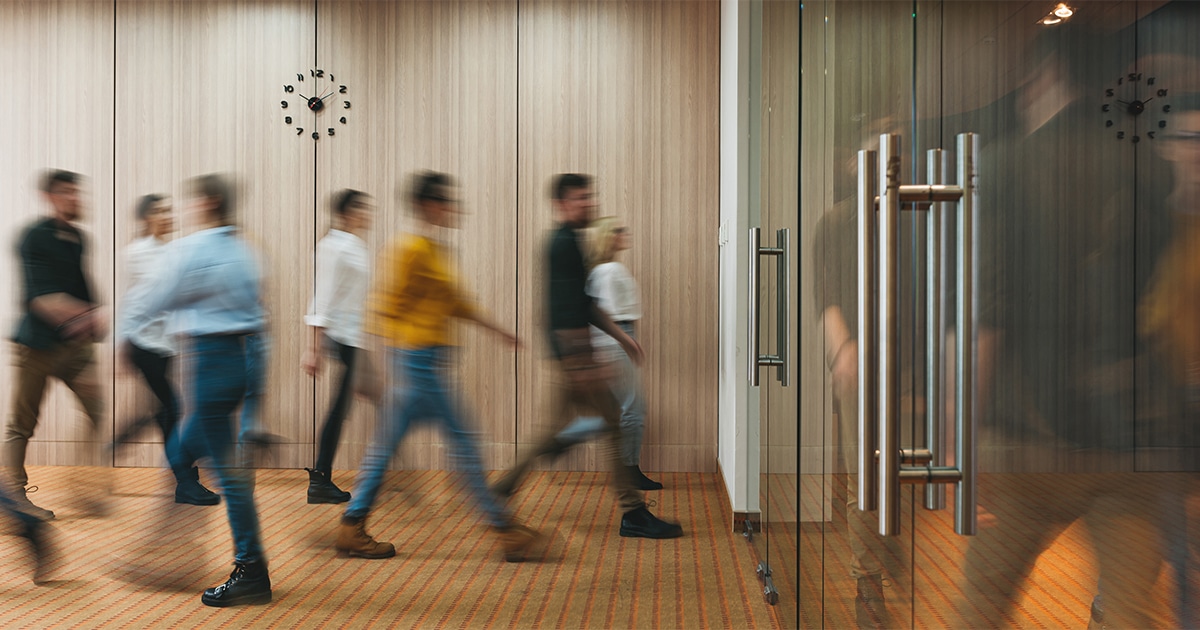One of the greatest challenges in preparing for the hybrid office (and one related to my last post) is the degree of uncertainty about usage patterns, both overall and day-to-day. While dynamism and choice are desirable from a talent retention point of view, too much flexibility can create problems if it results in space shortages or bottlenecks. One solution is to avoid the issue altogether by means of highly structured hybrid working policies, but it may be more effective to set policies or change the workplace in a way that tries to accommodate new workplace behaviors.
How does hybrid office dynamism present a real estate challenge?
The challenge of flexible working on a large scale is simply this: If employees’ independent choices tend to be clustered on the same times and days, the result is likely to be highly inefficient from a real estate perspective.
Imagine that workers are asked to come into the office at least three days a week and can choose which days those will be. What happens if the lion’s share of employees independently decides to work from home on Mondays and Fridays in order to sleep in a little longer after the weekend or avoid the end-of-week traffic?
If the real estate team renegotiated their lease on the assumption that the workforce would be distributed over the whole workweek, the result will likely be a crush at the office from Tuesday to Thursday, with people wasting a lot of time looking for available desks and resigning themselves to working from noisy spaces like the cafeteria for lack of space. If instead the real estate team anticipated this clustering behavior, the consequence is a lot of wasted space on Mondays and Fridays, and likely also excess staffing for the cleaning teams or security staff.
One solution that has been proposed is to schedule shifts or rotations at the office. Specific teams or departments would be assigned to certain days and office traffic will be largely predictable (with some room for error to accommodate drop-ins). This solution would likely be effective for space planning, with software scheduling and reservation tools used for easy assignment or reassignment. It would, however, also diminish employee choice and flexibility and reduce chance encounters between employees assigned to different rotations. In organizations with fluid teams, it could also result in unpredictable schedules, undermining some of the personal benefits of flexibility.
Addressing the challenge through monitoring
It may, however, not actually be necessary for every organization to set such strict policies to make hybrid working effective. The preceding scenario is simply one hypothetical and employees might naturally fall into different patterns. Parents, for example, might choose to build their office schedules around children’s pick-up and drop-off times, coming in to work part of the day every day. Other employees might set their office schedule according to the choices of their team or manager or might follow different schedules depending on the stage of their project. Young or new employees might choose to go to the office more often in search of mentoring and networking opportunities. Aggregated across an entire office, peaks and troughs in utilization might be far less extreme than in the previous hypothetical – or they might vary wildly across different offices.

Organizations that do not have to make their real estate choices immediately (perhaps because their leases still have several years on it) have the luxury of being able to assess how hybrid working dynamics are actually going to unfold. Sensors are a powerful tool for capturing historical trends surrounding peaks, troughs, averages, and flows of traffic across different locations and spaces. When their data is aggregated and run through analytics programs, real estate teams can use the findings to assess what the hybrid working patterns are and verify whether they are truly stable or change once the initial novelty of hybrid working wears off.
Those patterns can then be used to make data-driven real estate decisions that ensure that there is sufficient space to accommodate peak traffic without too much waste and to redesign office layouts or change seating patterns to accommodate flexible working. Other teams can use the data to make better decisions around service provisions and, if necessary, also introduce or redesign remote working policies based on transparent information.
This post is part of a blog series about the way IoT-related workplace technologies can facilitate a hybrid office and changing ways of working.








